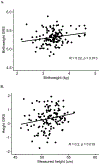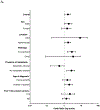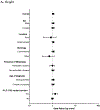Genetically inferred birthweight, height, and puberty timing and risk of osteosarcoma
- PMID: 37596165
- PMCID: PMC10869637
- DOI: 10.1016/j.canep.2023.102432
Genetically inferred birthweight, height, and puberty timing and risk of osteosarcoma
Abstract
Introduction: Several studies have linked increased risk of osteosarcoma with tall stature, high birthweight, and early puberty, although evidence is inconsistent. We used genetic risk scores (GRS) based on established genetic loci for these traits and evaluated associations between genetically inferred birthweight, height, and puberty timing with osteosarcoma.
Methods: Using genotype data from two genome-wide association studies, totaling 1039 cases and 2923 controls of European ancestry, association analyses were conducted using logistic regression for each study and meta-analyzed to estimate pooled odds ratios (ORs) and 95% confidence intervals (CIs). Subgroup analyses were conducted by case diagnosis age, metastasis status, tumor location, tumor histology, and presence of a known pathogenic variant in a cancer susceptibility gene.
Results: Genetically inferred higher birthweight was associated with an increased risk of osteosarcoma (OR =1.59, 95% CI 1.07-2.38, P = 0.02). This association was strongest in cases without metastatic disease (OR =2.46, 95% CI 1.44-4.19, P = 9.5 ×10-04). Although there was no overall association between osteosarcoma and genetically inferred taller stature (OR=1.06, 95% CI 0.96-1.17, P = 0.28), the GRS for taller stature was associated with an increased risk of osteosarcoma in 154 cases with a known pathogenic cancer susceptibility gene variant (OR=1.29, 95% CI 1.03-1.63, P = 0.03). There were no significant associations between the GRS for puberty timing and osteosarcoma.
Conclusion: A genetic propensity to higher birthweight was associated with increased osteosarcoma risk, suggesting that shared genetic factors or biological pathways that affect birthweight may contribute to osteosarcoma pathogenesis.
Keywords: Birthweight; Genetic risk score; Height; Osteosarcoma; Puberty timing.
Copyright © 2023. Published by Elsevier Ltd.
Conflict of interest statement
Declaration of Competing Interest The authors declare no conflict of interest.
Figures






References
-
- Gianferante DM, et al. , Germline and somatic genetics of osteosarcoma - connecting aetiology, biology and therapy, Nature reviews. Endocrinology 13(8) (2017) 480–491. - PubMed
MeSH terms
Grants and funding
LinkOut - more resources
Full Text Sources
Medical

